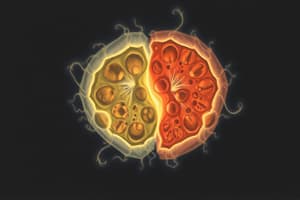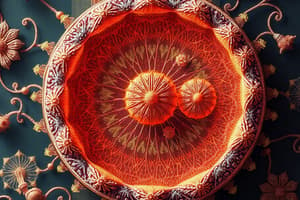Podcast
Questions and Answers
Identify the 5 stages of the cell cycle.
Identify the 5 stages of the cell cycle.
Telophase, Interphase, Prophase, Anaphase, Metaphase
Describe what occurs during each stage of the cell cycle.
Describe what occurs during each stage of the cell cycle.
Telophase; The nuclear membrane forms and gets ready for division. Interphase; The growth and development of the cell. Prophase; The chromatids pair up; nuclear membrane dissolves & centrioles & spindle fibers go to opposite ends. Anaphase; The chromosomes separate by the spindle fibers pulling them apart. Metaphase; The paired chromatids line up in the center of the cell.
What stages of the cell cycle are included in interphase?
What stages of the cell cycle are included in interphase?
Telophase
What is cytokinesis?
What is cytokinesis?
Predict what might happen if the cell never underwent cytokinesis.
Predict what might happen if the cell never underwent cytokinesis.
What is the relaxed form of DNA found in the nucleus?
What is the relaxed form of DNA found in the nucleus?
In preparation for the cell to undergo mitosis, the chromatin condenses into what type of structure?
In preparation for the cell to undergo mitosis, the chromatin condenses into what type of structure?
Define mitosis.
Define mitosis.
List the 4 stages of mitosis in the correct sequence.
List the 4 stages of mitosis in the correct sequence.
Describe the events that take place during prophase.
Describe the events that take place during prophase.
Identify the stage of mitosis in which the cell's chromosomes line up in the middle of the cell.
Identify the stage of mitosis in which the cell's chromosomes line up in the middle of the cell.
Describe the events that take place during anaphase.
Describe the events that take place during anaphase.
Describe the events that take place during telophase.
Describe the events that take place during telophase.
Describe the difference between plant and animal cells during cytokinesis.
Describe the difference between plant and animal cells during cytokinesis.
What activities are taking place in the cell during interphase?
What activities are taking place in the cell during interphase?
Explain the relationship between DNA, a chromosome, and chromatin.
Explain the relationship between DNA, a chromosome, and chromatin.
While looking through a microscope, you see a cleavage furrow develop. What stage is this cell in, and what type of cell is it?
While looking through a microscope, you see a cleavage furrow develop. What stage is this cell in, and what type of cell is it?
How does mitosis and meiosis differ?
How does mitosis and meiosis differ?
Describe how metaphase in mitosis differs from metaphase 1 in meiosis.
Describe how metaphase in mitosis differs from metaphase 1 in meiosis.
Define crossing over. When does it occur?
Define crossing over. When does it occur?
Describe each stage during meiosis 1.
Describe each stage during meiosis 1.
Compare meiosis 1 and meiosis 2.
Compare meiosis 1 and meiosis 2.
Predict what might happen if the sister chromatids did not separate during anaphase 2.
Predict what might happen if the sister chromatids did not separate during anaphase 2.
Infer how meiosis increases genetic variation.
Infer how meiosis increases genetic variation.
Infer why mitosis does not increase genetic variation.
Infer why mitosis does not increase genetic variation.
What stage of mitosis is depicted?
What stage of mitosis is depicted?
What stage of meiosis is depicted?
What stage of meiosis is depicted?
Flashcards are hidden until you start studying
Study Notes
Cell Cycle Overview
- The cell cycle consists of five stages: Telophase, Interphase, Prophase, Anaphase, and Metaphase.
- Interphase involves cell growth and preparation for division; it's subdivided into G1 (growth), S (DNA synthesis), and G2 (preparation for mitosis).
Stages of Mitosis
- Mitosis includes four main stages: Prophase, Metaphase, Anaphase, and Telophase.
- Prophase: Chromatin condenses into chromosomes, nuclear membrane dissolves, and spindle fibers begin to form.
- Metaphase: Chromosomes align along the cell's equator, facilitating even distribution to daughter cells.
- Anaphase: Sister chromatids separate and move towards opposite poles, pulled by spindle fibers.
- Telophase: The nuclear membrane reforms around separated chromatids, marking the near completion of mitosis.
Cytokinesis
- Cytokinesis is the physical process that divides the cytoplasm, resulting in two daughter cells.
- In plant cells, a cell plate forms; in animal cells, a cleavage furrow develops.
Chromatin and Chromosomes
- Chromatin is the relaxed form of DNA; it condenses to form chromosomes during cell division.
- Chromosomes are symmetrical structures, each consisting of two sister chromatids connected at a centromere.
Differences Between Mitosis and Meiosis
- Mitosis produces two genetically identical daughter cells from somatic cells, while meiosis produces four genetically different haploid cells from reproductive cells.
- Meiosis includes two rounds of division: Meiosis I and Meiosis II.
Genetic Variation in Meiosis
- Meiosis increases genetic diversity through crossing over (exchange of genetic material), occurring during prophase I.
- The result of meiosis is unique genetic combinations in offspring, contributing to species variation.
Anomalies in Cell Division
- Failure of cytokinesis leads to multinucleated cells, as no separation occurs after mitosis.
- If sister chromatids do not separate during anaphase II, resulting daughter cells will have inaccurate chromosome numbers.
Key Terminology
- Cytokinesis: Division of the cytoplasm following mitosis.
- Chromatids: Two identical halves of a duplicated chromosome.
- Synapsis: The pairing of homologous chromosomes during prophase I of meiosis, crucial for genetic recombination.
Summary of Meiosis Stages
- Meiosis I: Homologous chromosomes separate, resulting in two diploid cells.
- Meiosis II: Sister chromatids separate, resulting in four haploid gametes.
Application
- Understanding the stages of cell division is critical in fields such as genetics, developmental biology, and cancer research, where cell proliferation is a key factor.
Studying That Suits You
Use AI to generate personalized quizzes and flashcards to suit your learning preferences.




